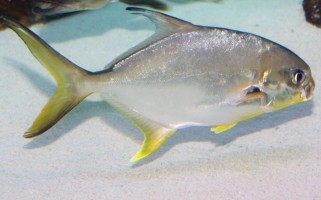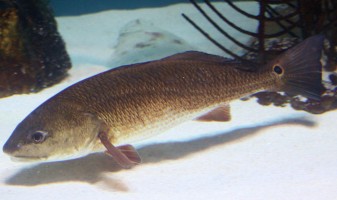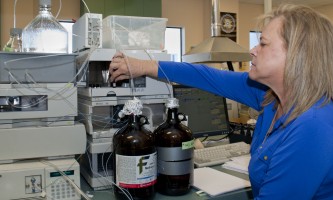Five years after Deepwater Horizon, research continues
The Deepwater Horizon oil rig sank on April 22, 2010, after an explosion on April 20 that killed 11 workers and set off one of the worst environmental disasters in our nation's history. Today, Mote Marine Laboratory is advancing new research related to the spill, focusing on the health of key fishes in the Gulf of Mexico.
Mote's latest research is part of the C-IMAGE II consortium of many institutions studying the spill, led by the University of South Florida. C-IMAGE and its latest iteration, C-IMAGE II, are both supported by the Gulf of Mexico Research Initiative. Mote senior scientist Dr. Dana Wetzel, Toxicology Task Lead in both C-IMAGE efforts, is working with scientists at Mote's sustainable aquaculture facility, Mote Aquaculture Park, to help shed further light on Deepwater Horizon and provide a head start in understanding other threats to Gulf fisheries for decades to come.
Researchers in the C-IMAGE II consortium have learned much about the spill and about what is needed to understand its impacts better (click here for a Q&A summary posted this week by USF). However, the possible long-term impacts of Deepwater Horizon may be subtle and not fully understood for years, and studies of the spill are complicated by a lack of “baseline data” showing the levels of contamination and the health of marine life before the spill.
“With humans, our health is monitored from birth by our doctor, so later in life we know our medical history and what has changed,” said Wetzel, manager of Mote’s Environmental Laboratory for Forensics. “We don’t have that luxury for fish in the Gulf of Mexico. We need to be able to look closely at how oil affects these animals, in a controlled setting, to better understand what we’re seeing now and to better prepare for the future.”
At Mote’s Environmental Laboratory for Forensics, Wetzel and her staff have already worked toward developing critically important sublethal health assessments for evaluating changes to immune function, reproductive potential and DNA damage in Gulf of Mexico fish exposed to oil. Their ultimate goal is the development of rapid health diagnostic tests that will better diagnose both short- and long-term impacts of oil exposure on fish.
Now, Working with USF and other partners in CIMAGE II, Mote is taking a new step toward advancing health diagnostics: They are examining how specific levels of oil components affect fish under highly controlled conditions in the lab. Lab studies will focus on three important Gulf of Mexico marine fishes — red drum, pompano, and southern flounder — to rigorously examine any oil-related changes in immune and reproductive health, viability of offspring and other traits important for maintaining populations.
These efforts are designed to complement recent and future field studies by multiple partners studying wild fish in the Gulf.
Wetzel will work together with Dr. Kevan Main, Director of Mote Aquaculture Park (MAP) in eastern Sarasota County, to study several fish species at the Park. MAP is Mote's innovative, 200-acre research facility that has developed and honed technologies to sustainably raise many of the important fishery species from the Gulf.
“There, we can carry out a controlled study with multiple species at different stages of their life cycles,” Wetzel said. “We can look at pompano that occupy inshore and nearshore waters, flounder that burrow in sediment, and red drum that are found in estuaries and bays. They represent the different kinds of habitats we need to further evaluate.”
Wetzel and colleagues will study key indicators in the health of these fishes, along with red snapper from another facility, in the presence of acute exposure to high levels of oil and dispersant that might occur with a spill, along with chronic long-term exposures that might persist in marine environments over time.
“We want to know how they are affected by an acute event like an oil spill, and whether they will be more severely affected if they have already been exposed to low levels of oil in the environment for some time,” Wetzel said.
More About Dr. Wetzel and the Environmental Laboratory for Forensics:
Dr. Wetzel has studied oil impacts on the natural environment since 1993. She and her colleagues in the Environmental Laboratory for Forensics (ELF) investigate the causes and effects of environmental stress in marine ecosystems, particularly focusing on oil and other contaminants such as PCBs, flame retardants, pesticides and other human-made substances. Dr. Wetzel studies a variety of species – from marine worms to fish, whales, manatees and polar bears – around the world using many methods. For example, the ELF lab assesses samples from marine life for fatty acids and lipid classes, possible changes in immune function, impacts on fertility and DNA damage resulting from environmental stressors.
Dr. Wetzel was one of the first researchers to respond to the Deepwater Horizon spill through methods such as long-term water and sediment sampling, studies of oil and coral larvae in the lab, studies of multiple wild-caught fish species and more. Today, as Toxicology Task Lead for C-IMAGE II, Dr. Wetzel is carrying out critically important studies of fish health in the lab designed to support development of more thorough health diagnostic tools for fish. Her goal is to shed more light on not only the impacts of Deepwater Horizon, but also on other environmental threats for decades to come.


